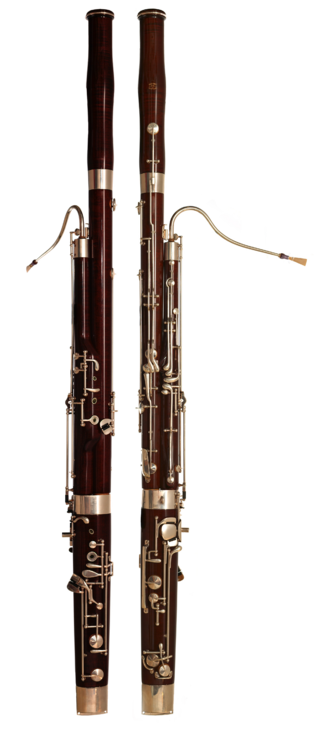Related Research Articles

The bassoon is a woodwind instrument in the woodwind family, which plays in the tenor and bass ranges. It is composed of six pieces, and is usually made of wood. It is known for its distinctive tone color, wide range, versatility, and virtuosity. It is a non-transposing instrument and typically its music is written in the bass and tenor clefs, and sometimes in the treble. There are two forms of modern bassoon: the Buffet and Heckel systems. It is typically played while sitting using a seat strap, but can be played while standing if the player has a harness to hold the instrument. Sound is produced by rolling both lips over the reed and blowing direct air pressure to cause the reed to vibrate. Its fingering system can be quite complex when compared to those of other instruments. Appearing in its modern form in the 19th century, the bassoon figures prominently in orchestral, concert band, and chamber music literature, and is occasionally heard in pop, rock, and jazz settings as well. One who plays a bassoon is called a bassoonist.

The oboe is a type of double reed woodwind instrument. Oboes are usually made of wood, but may also be made of synthetic materials, such as plastic, resin, or hybrid composites.

Woodwind instruments are a family of musical instruments within the greater category of wind instruments. Common examples include flute, clarinet, oboe, bassoon, and saxophone. There are two main types of woodwind instruments: flutes and reed instruments. The main distinction between these instruments and other wind instruments is the way in which they produce sound. All woodwinds produce sound by splitting the air blown into them on a sharp edge, such as a reed or a fipple. Despite the name, a woodwind may be made of any material, not just wood. Common examples include brass, silver, cane, as well as other metals such as gold and platinum. The saxophone, for example, though made of brass, is considered a woodwind because it requires a reed to produce sound. Occasionally, woodwinds are made of earthen materials, especially ocarinas.

A reed is a thin strip of material that vibrates to produce a sound on a musical instrument. Most woodwind instrument reeds are made from Arundo donax or synthetic material. Tuned reeds are made of metal or synthetics. Musical instruments are classified according to the type and number of reeds.

The Royal Society for the Protection of Birds (RSPB) is a charitable organisation registered in England and Wales and in Scotland. It was founded in 1889. It works to promote conservation and protection of birds and the wider environment through public awareness campaigns, petitions and through the operation of nature reserves throughout the United Kingdom.

The contrabassoon, also known as the double bassoon, is a larger version of the bassoon, sounding an octave lower. Its technique is similar to its smaller cousin, with a few notable differences.
The heckelphone is a musical instrument invented by Wilhelm Heckel and his sons. The idea to create the instrument was initiated by Richard Wagner, who suggested its concept at the occasion of a visit of Wilhelm Heckel in 1879. Introduced in 1904, it is similar to the oboe but, like the bass oboe, pitched an octave lower, the heckelphone having a significantly larger bore.

Humanists UK, known from 1967 until May 2017 as the British Humanist Association (BHA), is a charitable organisation which promotes secular humanism and aims to represent "people who seek to live good lives without religious or superstitious beliefs" in the United Kingdom by campaigning on issues relating to humanism, secularism, and human rights. It seeks to act as a representative body for non-religious people in the UK.
The bass oboe or baritone oboe is a double reed instrument in the woodwind family. It is essentially twice the size of a regular (soprano) oboe so it sounds an octave lower; it has a deep, full tone somewhat akin to that of its higher-pitched cousin, the English horn. The bass oboe is notated in the treble clef, sounding one octave lower than written. Its lowest sounding note is B2 (in scientific pitch notation), one octave and a semitone below middle C, although an extension with an additional key may be inserted between the lower joint and bell of the instrument in order to produce a low B♭2. The instrument's bocal or crook first curves away from and then toward the player (unlike the bocal/crook of the English horn and oboe d'amore), looking rather like a flattened metal question mark; another crook design resembles the shape of a bass clarinet neckpiece. The bass oboe uses its own double reed, similar to but larger than that of the English horn. compared to the bassoon

A double reed is a type of reed used to produce sound in various wind instruments. In contrast with a single reed instrument, where the instrument is played by channeling air against one piece of cane which vibrates against the mouthpiece and creates a sound, a double reed features two pieces of cane vibrating against each other. This means, for instruments with the double reed fully exposed, that the air flow can be controlled by the embouchure from the top, bottom and sides of the reed. The term double reeds can also refer collectively to the class of instruments which use double reeds.
The British Red Cross Society is the United Kingdom body of the worldwide neutral and impartial humanitarian network the International Red Cross and Red Crescent Movement. The society was formed in 1870, and is a registered charity with more than 17,200 volunteers and 3,400 staff. At the heart of their work is providing help to people in crisis, both in the UK and overseas. The Red Cross is committed to helping people without discrimination, regardless of their ethnic origin, nationality, political beliefs or religion. Queen Elizabeth II was the patron of the society until her death on 8 September 2022.

The reed contrabass is a metal double reed woodwind instrument in the bass-contrabass register, pitched in C. Although the bassoon-like double reed and metal construction make it superficially similar to a contrabass sarrusophone, it is descended from the ophicleide which it resembles in appearance, as well as in the arrangement of the simpler key work and fingering.
The International Double Reed Society (IDRS), is an organization that promotes the interests of double reed players, instrument manufacturers and enthusiasts. Services provided by the IDRS include an international oboe and bassoon competition, an annual conference, member directory, a library, information about grants, and publications, such as the society's own journal, The Double Reed.
William Waterhouse was an English bassoonist and musicologist. He played with notable orchestras, was a member of the Melos Ensemble, professor at the Royal Northern College of Music, author of the Yehudi Menuhin Music Guide "Bassoon", of The New Langwill Index, and contributor to the New Grove Dictionary of Music and Musicians.
Roger Birnstingl is a British classical bassoonist. He started playing the bassoon at age 14, Educated at Bedales School and later studied with Archie Camden at the Royal College of Music in London. He has served as principal bassoonist of the London Philharmonic (1956–1958), the Royal Philharmonic (1961–1964) and the London Symphony Orchestra (1964–1977). He later served as principal bassoonist with the Orchestre de la Suisse Romande until his retirement in 1997. He is currently professor of bassoon at the Geneva Conservatoire, where his students have included Carlo Colombo, principal bassoonist of the Lyon Opera Orchestra; and Kim Walker. He is also a joint president of the British Double Reed Society.
Hugo Fox was an American classical bassoonist. He also designed and manufactured bassoons and oboes.

Graham Waterhouse is an English composer and cellist who specializes in chamber music. He has composed a cello concerto, Three Pieces for Solo Cello and Variations for Cello Solo for his own instrument, and string quartets and compositions that juxtapose a quartet with a solo instrument, including Piccolo Quintet, Bassoon Quintet and the piano quintet Rhapsodie Macabre. He has set poetry for speaking voice and cello, such as Der Handschuh, and has written song cycles. His compositions reflect the individual capacity and character of players and instruments, from the piccolo to the contrabassoon.
Lyndon Jeffrey Frank Watts is an Australian bassoonist. He is principal bassoonist of the Münchner Philharmoniker and an academic teacher.
Julie Price is an English bassoonist. She is principal bassoonist of the BBC Symphony Orchestra.
Elisabeth Waterhouse is an English pianist and music pedagogue. She founded the National Chamber Music Course, a summer school for young string players, in 1974, and has managed it since. She is the widow of the bassoonist and musicologist William Waterhouse.
References
- 1 2 "Membership". bdrs.org.uk. British Double Reed Society. Retrieved 22 September 2017.
- ↑ Newman, Gareth (Fall 1989). "The 1989 IDRS Conference - A Personal View". The Double Reed. International Double Reed Society. 12 (2).
- ↑ "About us". bdrs.org.uk. British Double Reed Society. Retrieved 22 September 2017.